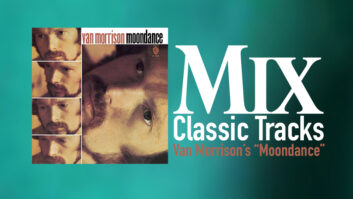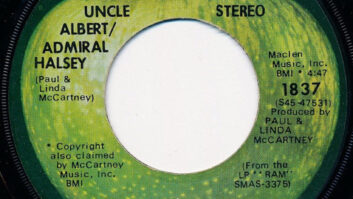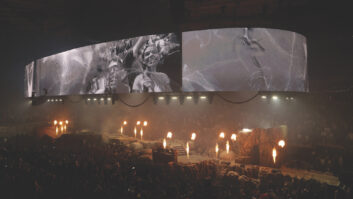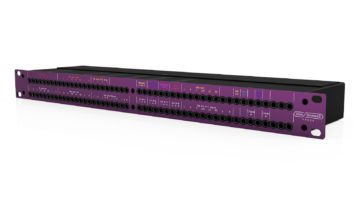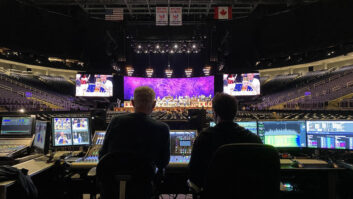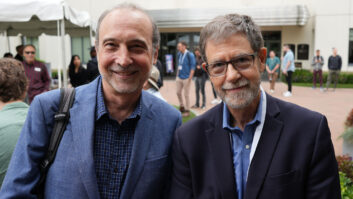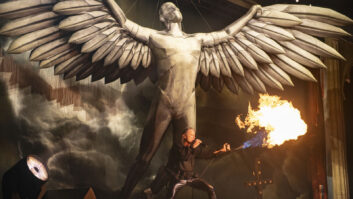POP TO CLASSICAL TO POETRYEngineer/producer Dixon Van Winkle has traveled many miles in a career that spans three decades, but his story begins in the sleepy upstate town of Ogdensburg, New York. A fine place, but if your goal is to work in the music business with the likes of Paul McCartney, Frank Sinatra, Paul Simon and Dizzy Gillespie, chances are you’ll one day set off on the road heading out of town.
“Both my parents were musicians,” he says. “My mom was a vocal teacher, and my dad ran the high school band. He was a very creative guy. When I was in the fifth grade, he started teaching me different brass instruments and eventually the acoustic bass. From then on until I graduated high school, he had me sitting in with different ensembles and eventually going out on the road with him in dance bands. We went all over the north country together, carrying the official Glenn Miller books. My dad had it in his mind that I’d be playing tuba and bass like the guy in the back of Guy Lombardo’s band. It was a great experience.”
But if you stay in a small town long enough, you’re likely to wind up in trouble – even if you play the baritone horn instead of quarterback. “I was taking my father’s car and getting into some trouble, and I had pretty much outgrown the level of musical training in Ogdensburg, so my parents sent me to the Interlochen Arts Academy for my senior high school year, and the summer before I’d attended a music festival in Burlington, Va. That’s where I first met Bobby Ludwig.”
Interlochen led to the Eastman School of Music, followed by a couple of years kicking around upstate teaching band and playing in clubs. In 1969, Dixon met Phil Ramone. “Phil was already enormously successful by that point,” Van Winkle says. “He was teaching a course on engineering with a couple of other guys, and it was there that I first got my hands on a multitrack – Phil brought out an 8-track recording of the Broadway musical Promises, Promises and let us go at it. Phil thought I showed promise and told me he’d make me a star if I came to New York, so down I went.”
Young people looking to become studio engineers started out in the ’60s, just as they do today: “I was a setup man at Phil’s studio, A&R Recording. There was a lot of young talent in that place: Don Hahn, Elliot Scheiner, Tony May, Bob Ludwig to name a few. One day, Tony May was over in Studio A1 tracking a Van Morrison session. The setup man got sick. I had been there a month, was really green and they stuck me on the date. Van was grooving along with his band, and I see Tony making a motion to me with his finger. I can’t figure out what he’s doing, but he’s got a nasty look on his face. He makes the same motion again. The band’s wailing, but I push the stop button on the tape machine and stop the take. Well, they were recording `Moondance,’ take 1. Take 2 was the keeper, the one that became a monster hit! That was back in ’69.”
After a year’s apprenticeship, Dixon got his first big break. Paul McCartney came to A&R to record Ram, his second solo album, with Phil Ramone behind the board. Swamped with projects by this time, Ramone turned the reins over to Van Winkle. “What a ball I had! Paul felt comfortable with me. Each day he and Linda, along with their baby, Mary, would be led up to Studio A in a back elevator. We’d set up a playpen for Mary and go to work. I also worked on Red Rose Speedway. Paul is such a pro! And he’s a one-taker. Paul liked to develop ideas in the studio, and he encouraged me to throw different sounds at him to inspire him. For example, he’d play his guitar, and I’d put different loop and echo effects on it and feed the processed sound out through his cans. He liked that spontaneity. One day he was standing around strumming on a ukulele, rocking from side to side, singing `Ram On.’ I ran out and put a mic on the ukulele, one on his face and a pair of mics down by his feet. The tapping you hear comes from the mics on his feet. We were recording to an Ampex MM1000 16-track machine that looked like something you should be making ice cream with.
“Once word got out that I’d done a lot of work on Ram, the dates flew at me,” he continues. “People started to realize that I could handle most any kind of session, since I could read charts and had played lots of different styles of music and many instruments.”
Interesting stories? “Well, I remember the Benny Goodman session I did. Poor guy – his front teeth were worn away from biting down on his mouthpiece all those years. I tracked Sinatra singing `Send in the Clowns.’ He was like Paul in a way – a fabulous professional, a true one-take singer. He’d get the lights turned down just the way he liked them, have the staff set him up with a bottle of Dewar’s and get down to business. The New York Dolls were pretty cool. And I loved the jingle scene – you’d get all these great players and guys like Mike Maneiri writing great charts. It was fast-paced, clean work. I was also coming into the studio on the weekends to produce a band called The Rhythm Boys. The band included pals from college: Steve Gadd, who was in the Air Force Men of Note band; Michael Holmes who was in the Marine band; and Tony Levin. Steve and Michael would come up from Washington on the weekends to work in the studio, and Tony would crash at my place. It was their first experience in a major-league recording studio. We cut two albums that were never released.”
About six years into the A&R experience, a pair of Canadian businessman called and asked Dixon to move to Montreal and help start a recording label. “The deal gave me unlimited studio time in exchange for engineering and producing the company’s jingles. It was a beautiful studio with a charming little French restaurant right outside the studio doors. I went for it!”
Scouring Canada for talent, Dixon eventually found Men Without Hats. Together they produced the Platinum record Safety Dance. By 1991, however, Dixon’s kids were grown, and he was pulled back towards the energy of New York. “I talked with David Smith, a good friend from A&R days, who was connected with Sony Classical. David made some introductions, and I’ve been freelancing at Sony ever since.”
Large chunks of Dixon’s time these days are spent remixing and mastering archival material from the Sony catalog for the new SACD format. “What a privilege!” he says. “I sit at a workstation with scores in front of me working on the best orchestral recordings ever made by the likes of the Cleveland, Philadelphia, New York and Columbia Symphony orchestras. Bernstein, George Szell, Bruno Walter – these are the kinds of conductors I get to listen to! Right now, we’re re-issuing all of Szell’s work with the Cleveland Orchestra. It’s amazing and rare to find any edits in Szell’s work!”
What kind of remixing is required? “For one thing, engineers at the time made some artistic decisions. For example, an engineer might think that the trumpets were too soft and raise the fader at a moment in a piece. Looking at the score, it might be clear that the composer’s and conductor’s intentions were being altered. So levels need to be adjusted back to where they should be.”
Working with a Sonic Solutions workstation, Dixon also removes clicks and pops, making new 24-bit, 88.2kHz masters. Eventually, this material is changed into DSD (Direct Stream Digital) and then into SACD masters. DSD and DVD-A are not compatible, and Van Winkle acknowledges that a shoot-out between the two formats seems likely. “I’ve never heard DVD-A material, but DSD sounds great. We did a test recently over a two-day period at Sony. We brought in a live band that included Randy Brecker, Andy Le Vern, George Mraz and Al Foster. While they played live on the floor, we had a four-way switch operating in the control room. We brought in high-level industry people, including Tom Jung, Bob Ludwig, Phil Ramone and Denny Purcell and let them flip the switch around between the source, a 16-bit recorder, a 20-bit machine and the DSD unit. The results of this blindfold test were universal; everyone could identify the recorders as an inexact copy of the source, with the exception of the DSD machine. None could hear any significant difference between the source and DSD!”
Dixon Van Winkle co-produced, tracked and mixed this year’s Grammy-winning Best New Age Album, Celtic Solstice, by Paul Winter, with whom he’s worked on and off since 1980. Dixon says, “I could spend all my time at Paul’s barn/studio up in Connecticut. It’s such an inspiring place to work. Paul’s got a huge farm with a big barn for making great music. Paul likes to get a bunch of great players in neat recording spaces like his barn or St. John’s Cathedral in NYC. He doesn’t overanalyze. He’ll let his players improvise on tape. Then, he studies what’s been recorded and writes melodies and chord changes around the best bits. After that, we’ll have more sessions, a second, third, maybe even a fourth or fifth, to piece a tune together.”
Dixon and his wife recently formed their own label, The Van Winkle Clef. “We put the label together to release a project I really love based on the work of the great Russian poet Yvgeny Yevtushenko. The record, which includes a book of poetry, is titled The City of Yes and the City of No. The recording was done in Paul Winter’s barn with an invited audience. Members of The Paul Winter Consort improvised, while Yevtushenko read his selections of his poetry, mostly in English. It was a happening. I tracked everything through an 02R to DA-88 and brought the material back to New York and then edited on a Sonic Solutions workstation. The recording is wonderful.
“We plan to follow the Yevtushenko record with a whole series of spoken word recordings, marketed and distributed through The Van Winkle Clef. I love working with Paul Winter and will continue that as long as I can. And, I’m excited to be working on the archival recordings for Sony Classical. Interesting people and ideas seem to be all around, and I love being busy. I’ll never retire!”
